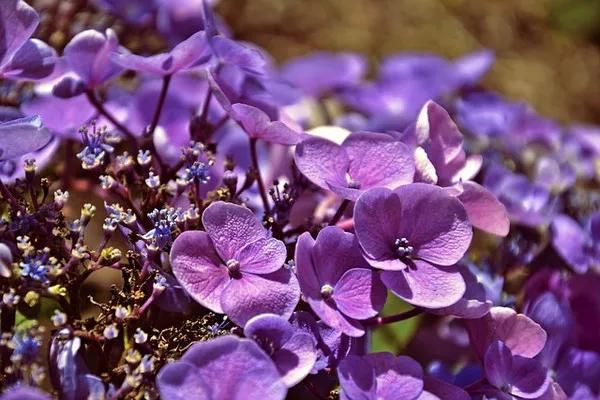Hydrangeas, with their stunning blooms and diverse color palette, have long been a favorite among garden enthusiasts. One of the most intriguing aspects of these flowering plants is their ability to change blossom colors, captivating gardeners and botanists alike. In this article, we will delve into the fascinating science behind the phenomenon of hydrangea flower color transformation.
Understanding the Basics:
To comprehend the mechanics of hydrangea color change, it is essential to grasp the role of soil pH in influencing flower pigments. Hydrangeas exhibit a range of colors, including blue, pink, purple, and even green, depending on the acidity or alkalinity of the soil they are planted in. The key players in this color game are anthocyanins, water-soluble pigments responsible for the red, purple, and blue hues in flowers.
Soil pH’s Impact:
The pH level of the soil determines the availability of aluminum ions, which play a pivotal role in the formation of anthocyanins. In acidic soils with a pH below 6, hydrangeas absorb aluminum more efficiently, leading to the synthesis of blue pigments. On the other hand, in alkaline soils with a pH above 6, aluminum becomes less accessible, resulting in the production of pink and red pigments.
Blue Hydrangeas: The Acidic Affair
For those desiring a mesmerizing display of blue hydrangeas, the key lies in maintaining an acidic soil environment. When the soil pH is below 6, aluminum is readily absorbed by the plant’s roots. The absorbed aluminum, in conjunction with anthocyanins, creates the vibrant blue shades that have become synonymous with certain hydrangea varieties like Hydrangea macrophylla ‘Nikko Blue’ and ‘Endless Summer.’
Achieving the desired blue hue involves more than just planting in acidic soil. Gardeners can enhance the effect by incorporating organic matter, such as pine bark or peat moss, into the soil. Additionally, the application of aluminum sulfate can be employed to lower pH levels and boost aluminum availability, intensifying the blue tones.
Pink Hydrangeas: The Alkaline Allure
Conversely, for those enchanted by the delicate allure of pink hydrangeas, cultivating an alkaline soil environment is crucial. In alkaline conditions (pH above 6), aluminum availability diminishes, steering the plant towards the production of anthocyanins in shades of pink and red. Popular pink varieties like Hydrangea macrophylla ‘Bloomstruck’ and ‘All Summer Beauty’ flourish in alkaline soils.
To promote the development of pink hues, gardeners can add lime to the soil, effectively raising the pH level. Wood ashes, crushed eggshells, or dolomitic limestone can also be used as amendments. This manipulation of soil chemistry encourages the hydrangea to produce pigments that manifest as stunning pink blossoms.
Purple Hydrangeas: A Balancing Act
For those seeking a harmonious blend of blue and pink, creating a balanced soil environment is the key. In soils with a neutral pH around 6, hydrangeas often display a captivating mix of both blue and pink tones, resulting in various shades of purple. Varieties like Hydrangea macrophylla ‘Twist-n-Shout’ and ‘Masja’ showcase the beauty of this natural color transition.
Maintaining a neutral pH can be achieved by testing the soil regularly and adjusting amendments accordingly. While this approach may not yield the vibrant extremes seen in acidic or alkaline conditions, it offers a unique and balanced color spectrum that appeals to many garden enthusiasts.
Green Hydrangeas: The Enigmatic Exception
Intriguingly, some hydrangeas defy the conventional color spectrum, boasting lush green blossoms. The secret behind this enigma lies in the absence of anthocyanins. In these unique varieties, the pigments responsible for the blue and pink hues are not synthesized, allowing the natural green color of chlorophyll to dominate. Examples of green hydrangeas include Hydrangea macrophylla ‘Limelight’ and ‘Green Magic.’
While soil pH plays a role in the overall health and growth of green hydrangeas, the absence of anthocyanins means that these varieties remain unaffected by pH-induced color changes. Gardeners can cultivate green hydrangeas in a variety of soil types without the need for specific pH adjustments.
Conclusion:
Hydrangeas, with their chameleon-like ability to transform blossom colors, continue to captivate and inspire gardeners around the world. Understanding the science behind this color-changing phenomenon empowers enthusiasts to cultivate their desired hues, whether it be the striking blues of acidic soils, the delicate pinks of alkaline environments, the balanced purples of neutral pH, or the mysterious greens of anthocyanin-deficient varieties. As we unravel the mysteries of hydrangea flower color transformation, the garden becomes a canvas for botanical artistry, where soil pH serves as the brush, and the hydrangea, the ever-changing masterpiece.


